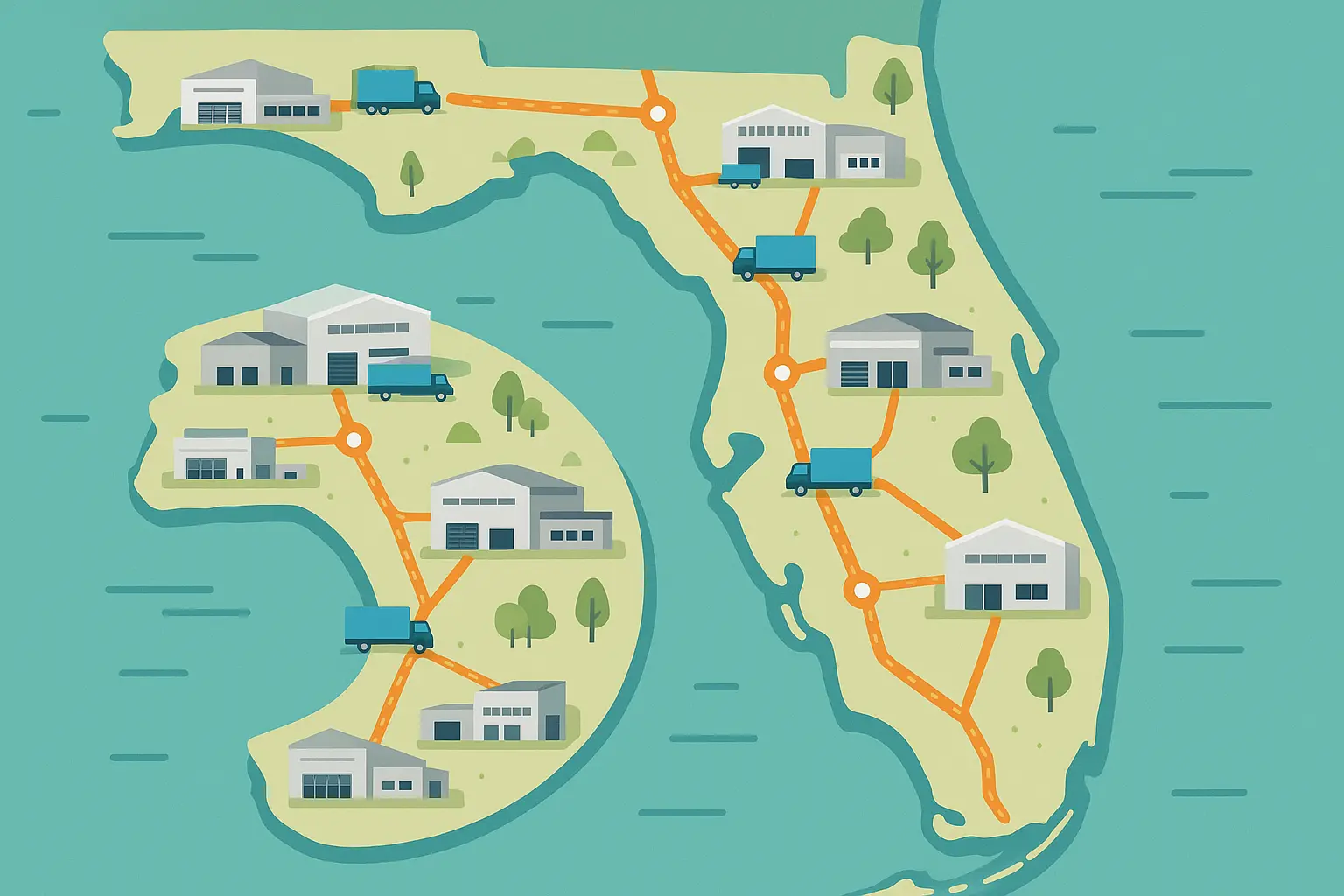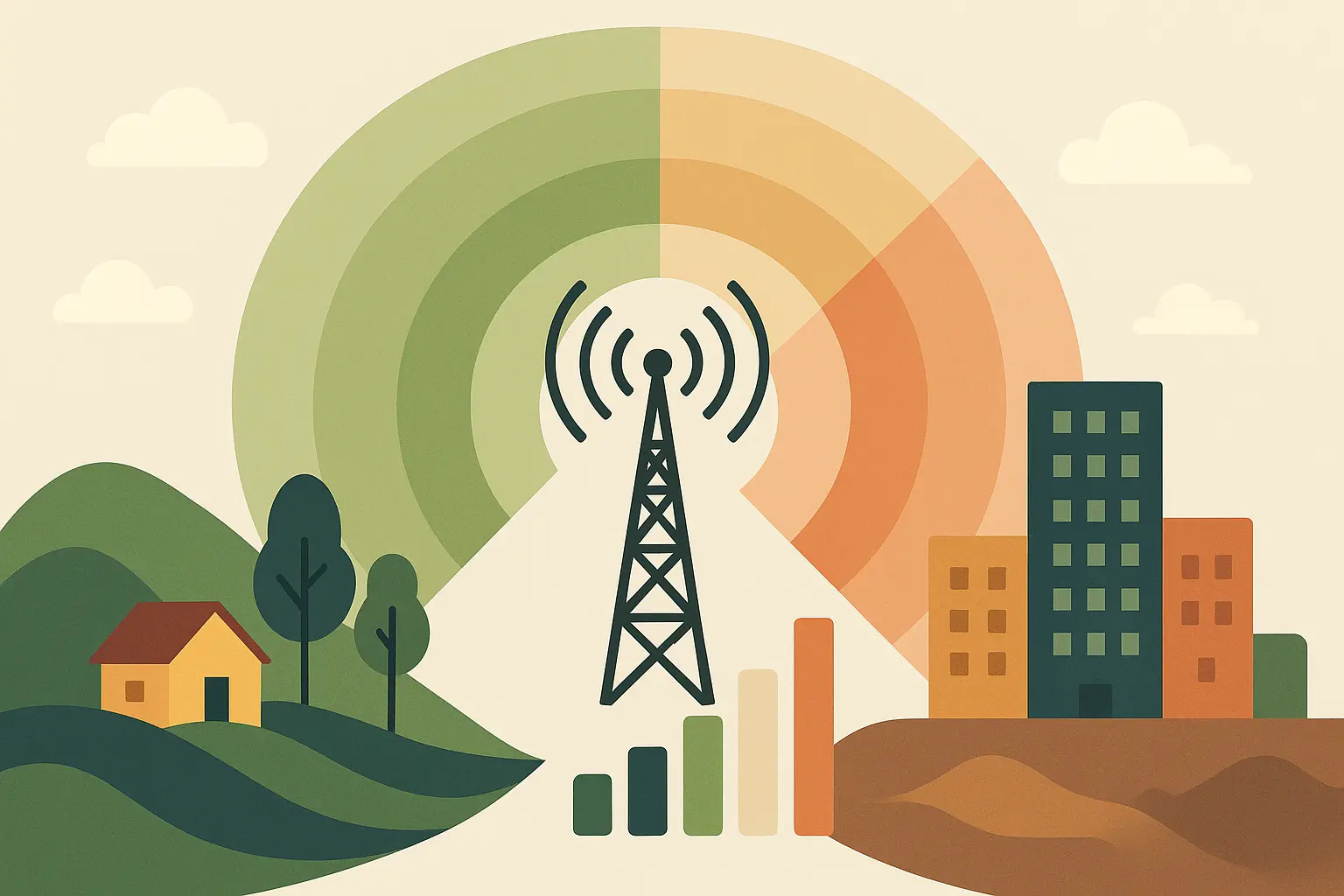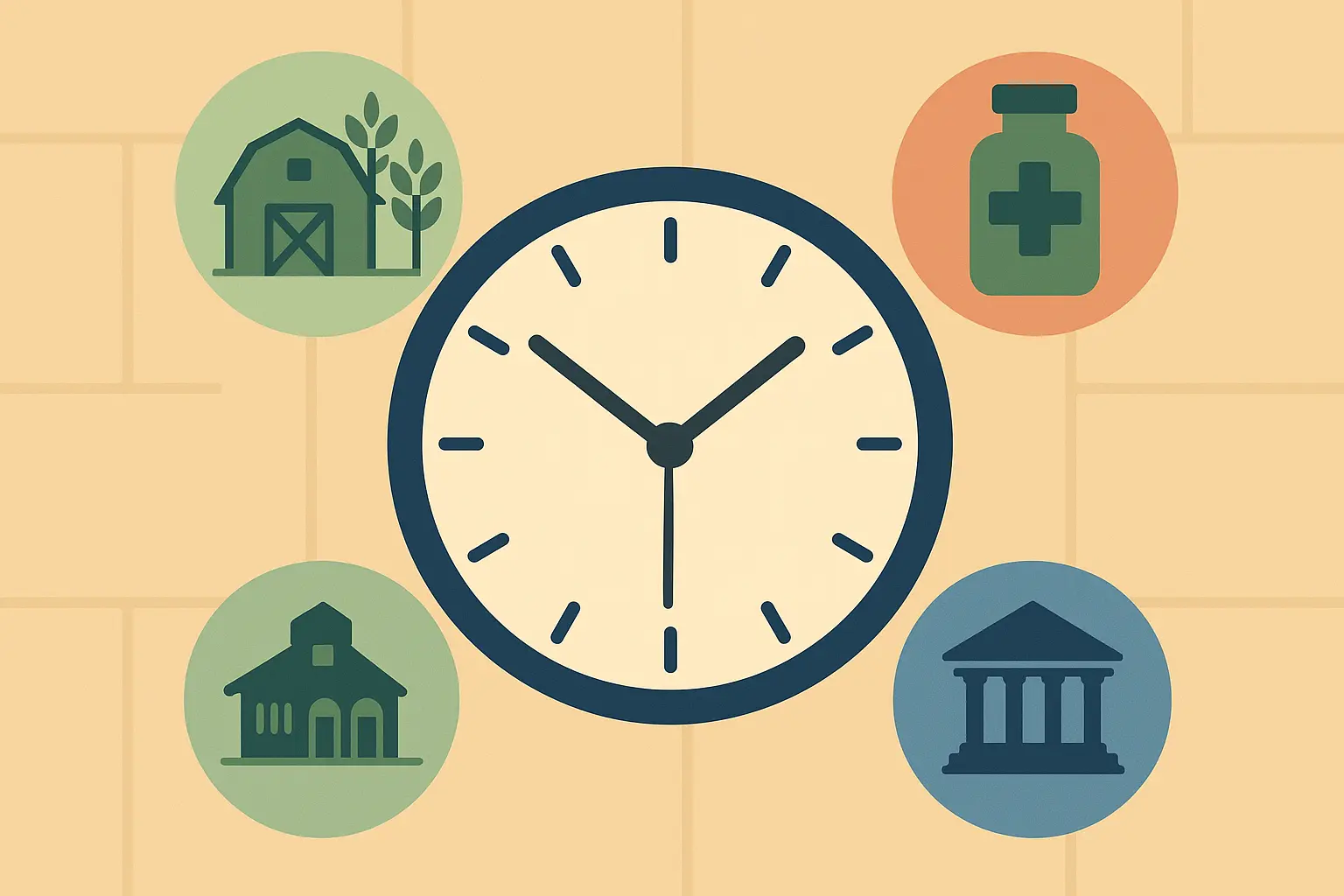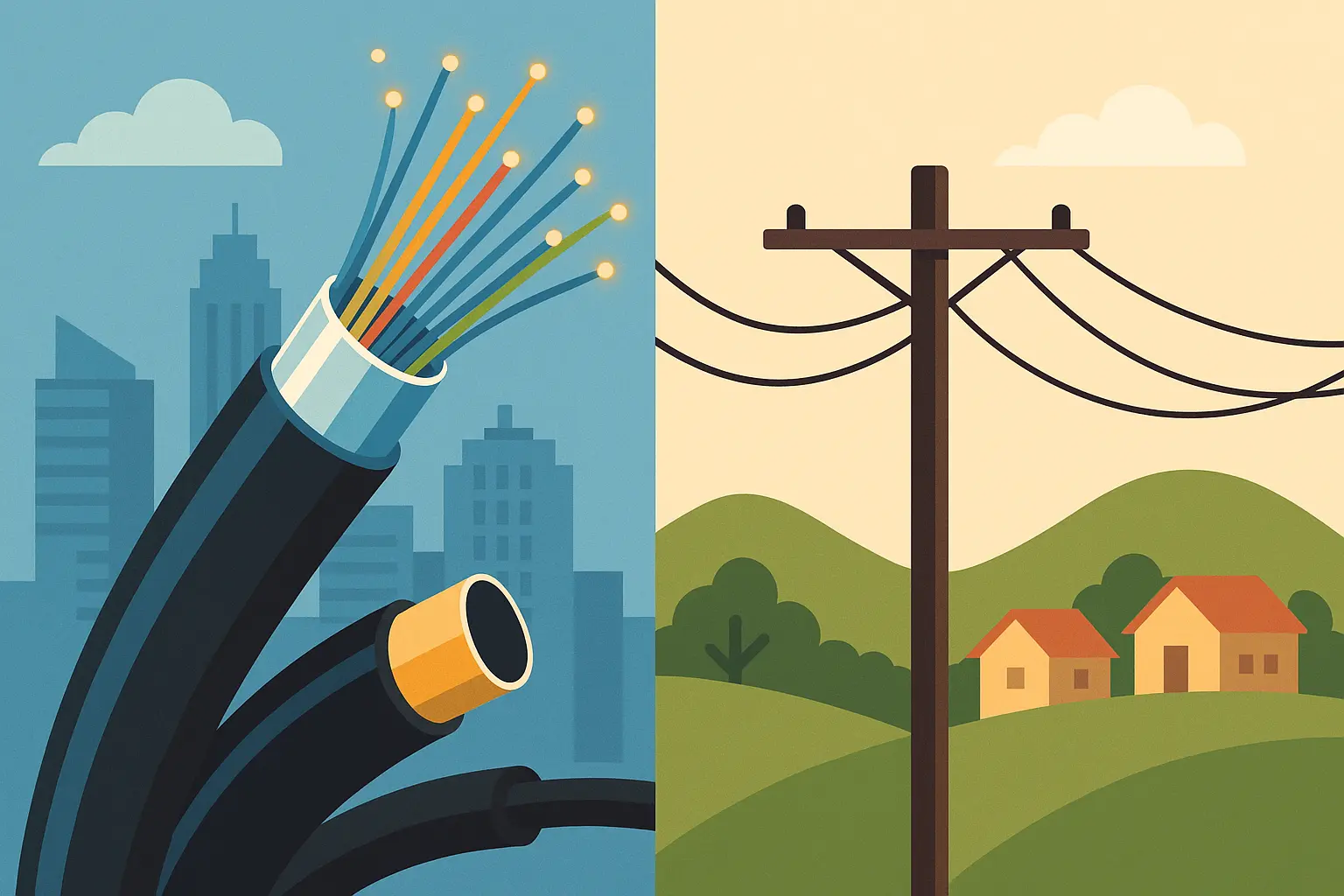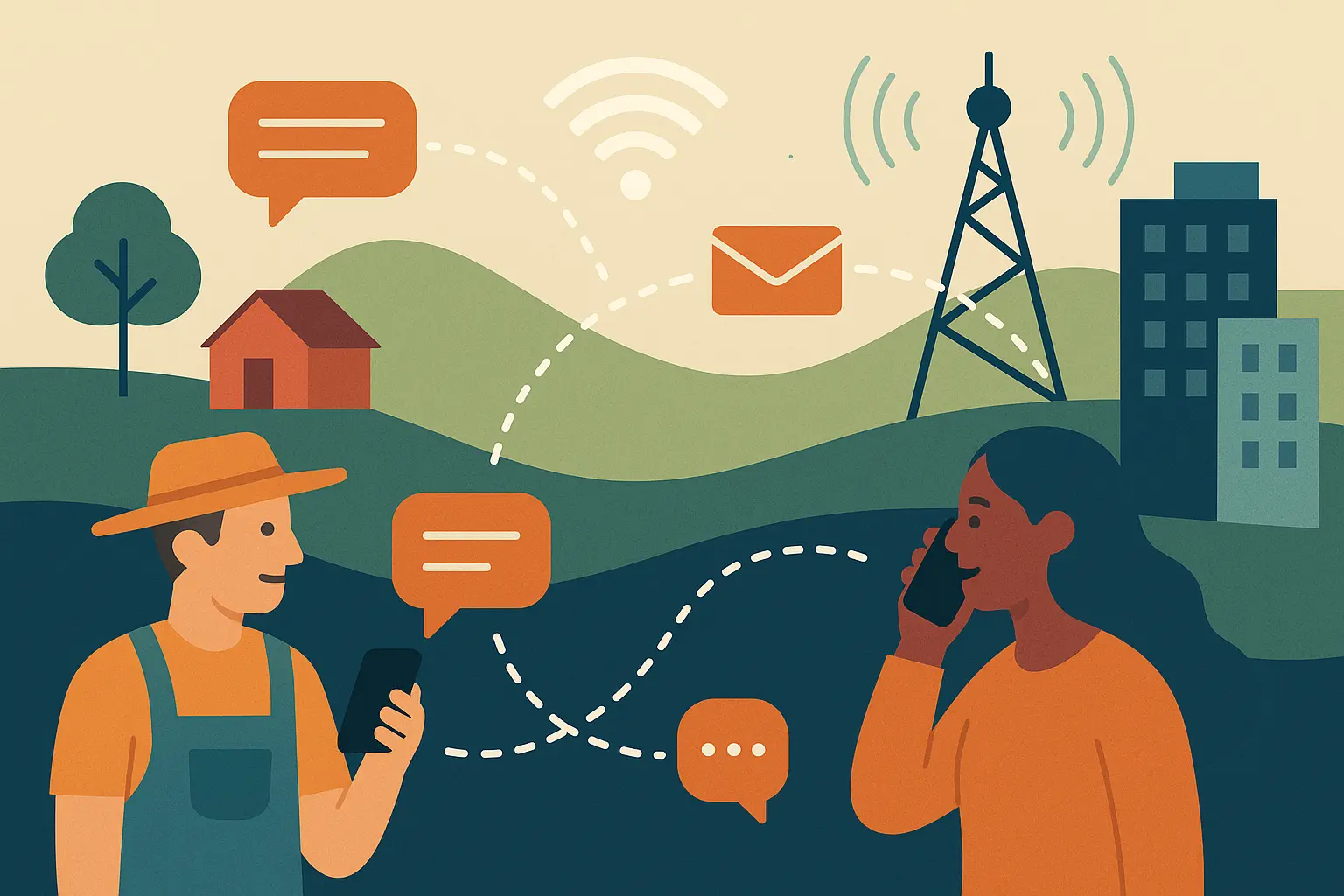The 352 area code covers 1,668,150 people across 13 counties in north-central Florida. While everyone focuses on coastal Florida, this inland region is quietly becoming one of America’s most interesting business markets – if you know how to work with its unique challenges.
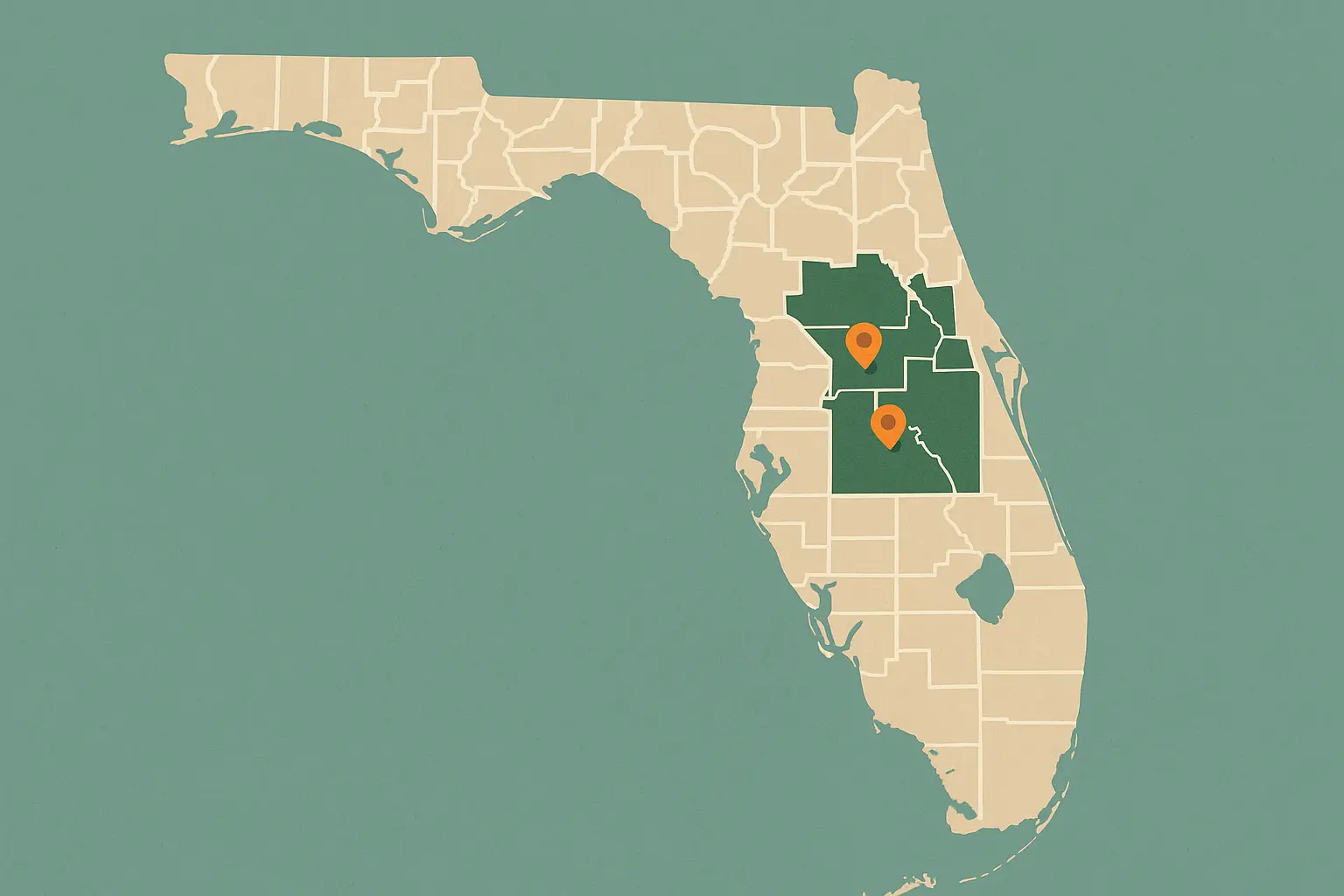
Table of Contents
Table of Contents
- Why 352 Isn’t Just Another Florida Area Code
- The Hidden Economic Mix Behind Those Numbers
- Geographic Realities That Trip Up Most Businesses
- Communication Challenges Nobody Talks About
- Time Zone Coordination and Business Rhythms
- Digital Divide Reality Check
- What Actually Works in Practice
- How Simple Solutions Fix Complex Problems
TL;DR
- The 352 area code spans 13 counties mixing cattle ranches, university towns, and retiree communities – each with different communication needs
- Rural cellular dead zones mean your standard business messaging often fails when you need it most
- Peak business hours vary wildly – ranchers start before dawn, students expect instant responses, retirees prefer afternoons
- SMS forwarding becomes essential when cellular coverage fails in counties like Levy and Gilchrist
- You need different communication strategies for agricultural clients, university customers, and seasonal residents
- Simple backup systems often work better than expensive solutions that don’t account for local infrastructure realities
Why 352 Isn’t Just Another Florida Area Code
Most people think Florida area codes are all about beaches and tourism. The 352 area code tells a completely different story. You’ve got cattle ranches next to tech startups, world-class university research facilities down the road from family farms that have been operating for generations.
The median age in the 352 area is 48 years – significantly older than coastal Florida regions. This creates a market where your customers might include a 25-year-old software developer and a 70-year-old cattle rancher, both expecting completely different communication styles and response times.
The Numbers Behind the Change
The area is changing fast. Retirees are moving inland for affordability. Young professionals are drawn to emerging tech hubs around Gainesville. Multi-generational farming families are adapting to modern agricultural technology.
This creates real challenges. A feed supplier I know was losing orders from horse farms because their standard business hours messaging system missed early morning orders from trainers who start work at 5 AM. After setting up SMS forwarding to email, they could respond to urgent supply requests even when their main office wasn’t open. Rural sales increased by 35%.
When you’re managing customers across different parts of the 352 region, how to forward text messages to an email address ensures your messages get through regardless of cellular coverage variations between urban and rural areas.
| Customer Type | How They Prefer Contact | When They Respond | Backup Needs |
|---|---|---|---|
| University Students/Faculty | Apps, instant messaging | 9 AM – 5 PM weekdays | Email for important stuff |
| Agricultural Operations | SMS, phone calls | 5 AM – 8 AM, 6 PM – 8 PM | Essential for rural areas |
| Retiree Communities | Traditional SMS, email | 10 AM – 2 PM weekdays | Seasonal forwarding |
| Healthcare Professionals | Secure messaging | 24/7 availability | Compliance documentation |
Economic Reality Check
The transition from agriculture-dominated economy to mixed services, healthcare, and technology creates distinct communication headaches. Businesses struggle because they’re using one approach for customers spanning everything from traditional farming operations to cutting-edge medical research facilities.
Healthcare facilities operate around the clock and need immediate response capabilities. Agricultural operations start before dawn and need systems that work in remote areas. University-related businesses follow academic calendars with predictable but intense volume swings.
The 352 area code encompasses this economic diversity in ways that create both opportunities and headaches for businesses trying to serve multiple market segments effectively.
The Hidden Economic Mix Behind Those Numbers
How Counties Connect (And Why It Matters)
The 352 area code covers 13 counties that most businesses treat as separate markets. That’s a mistake. Alachua County (home to Gainesville and UF) serves as the educational and medical hub, but it’s deeply connected to Marion County’s horse industry and Lake County’s tourism spillover from Orlando.
Marion County’s horse farms rely on veterinary services from Gainesville. Lake County’s tourism businesses coordinate with suppliers throughout the region. These connections create communication patterns that smart businesses can anticipate and use.
Primary Economic Centers
Gainesville dominates as the research and healthcare center, but don’t overlook Ocala’s horse industry or The Villages’ massive retiree population. Each operates on different business rhythms – medical facilities need 24/7 communication reliability, horse farms have early morning needs, and retiree communities have specific seasonal patterns.
A veterinary supply company serving the 352 region was losing orders from horse farms because their standard business hours system missed early morning orders from trainers. After implementing SMS forwarding to email, they could respond to urgent supply requests even when their main office wasn’t open, increasing rural sales by 35%.
Secondary Opportunities
Lake County’s proximity to Orlando creates spillover opportunities most businesses miss. During peak tourism seasons, you’ll see increased customer service inquiries and logistics coordination needs. If your SMS system can’t handle volume spikes or forward messages when cellular towers get overloaded, you’re losing business to competitors who figured this out.
The 352 region benefits from Orlando’s tourism economy without the high costs of being directly in the theme park corridor. Service providers, suppliers, and logistics companies can capture this market if they have communication systems robust enough to handle seasonal volume changes.
Strategic Location Advantages
The 352 area code sits at a logistics sweet spot. I-75 runs right through the heart of this territory, making it a distribution hub. Trucking companies, agricultural suppliers, and e-commerce fulfillment centers are setting up here because they can reach both coasts efficiently while keeping costs lower than Miami or Tampa.
With 49.4% of people in the labor force, the region maintains strong employment that supports both traditional industries and emerging sectors. This employment stability creates consistent demand for business services while providing the workforce needed for economic growth.
Distribution centers in the 352 area can reach Jacksonville in two hours, Tampa in 90 minutes, and Orlando in an hour. This geographic advantage only works if your communication systems can coordinate logistics across multiple areas and handle the rural coverage challenges that come with interstate commerce.
Geographic Realities That Trip Up Most Businesses
Rural-Urban Communication Gaps
Here’s what catches businesses off guard about the 352 area: you can drive 30 minutes from a world-class university with fiber internet to rural areas where cellular coverage is spotty at best. Counties like Dixie and Lafayette still have dead zones where your standard business communication tools simply don’t work.
For businesses operating across the varied terrain of the 352 area, getting started with AutoForward SMS for the first time provides essential setup guidance for ensuring reliable message delivery in both urban and rural coverage areas.
A medical equipment supplier discovered this challenge when they couldn’t reach a rural clinic in Levy County during a critical equipment failure. Their standard SMS alerts weren’t getting through due to poor cellular coverage. After implementing SMS-to-email forwarding, the clinic staff could receive critical alerts through their satellite internet connection, ensuring patient care continuity even when cellular service failed.
Network Coverage Reality
Cellular coverage across the 352 region is inconsistent. You might have perfect 5G in downtown Gainesville, then lose signal completely 15 miles out in rural Alachua County. For businesses operating across this region, SMS forwarding to email isn’t just convenient – it’s essential for maintaining customer relationships when direct messaging fails.
Rural areas within the 352 area code often rely on satellite internet or fixed wireless connections that work better for email than cellular messaging. Understanding these infrastructure realities helps you design communication strategies that actually reach your customers.
Infrastructure Development Patterns
Infrastructure investment is flowing into the 352 area, but unevenly. Major corridors along I-75 and around university areas are getting upgraded first, while rural agricultural areas lag behind. Understanding these development patterns helps you predict where communication challenges will persist and where they’ll improve.
Fiber optic expansion follows population density and commercial development. The 352 region’s rural counties will likely see infrastructure improvements over the next decade, but you can’t wait for perfect coverage to serve these markets effectively.
Population Density Variations
The contrast between Gainesville’s university density and rural counties like Levy is stark, and it affects everything from customer service expectations to optimal messaging times. University areas expect instant responses and prefer app-based communication, while rural customers often rely on traditional SMS and have more patience for delayed responses – but zero tolerance for missed messages.
The average household size in the 352 area is 2.4 people, which affects how you should structure family-oriented communications across the diverse demographic landscape. Rural households often include multiple generations with different communication preferences, while university areas have more single-person households with consistent tech adoption patterns.
Communication Challenges Nobody Talks About
Multi-Generational Message Management
Managing communication across the 352 area’s demographic mix requires juggling multiple channels simultaneously. Businesses struggle because they’re trying to serve tech-savvy university students, traditional farmers, and retirees with the same communication strategy.
The 352 area presents unique challenges because these demographic groups often live within miles of each other but operate in completely different communication worlds.
Technology Adoption Differences
Younger populations around UF prefer app-based messaging and expect immediate responses, while rural and older demographics rely heavily on traditional SMS and phone calls. The challenge isn’t choosing one approach – it’s creating systems that handle both effectively.
University students expect instant notifications through multiple apps. Agricultural professionals need reliable SMS that works in remote locations. Retirees prefer email communication with clear documentation. Your communication strategy needs to accommodate all three simultaneously within the same geographic region.
Professional Communication Standards
Healthcare, legal, and agricultural professionals in the 352 region need documented communication trails for compliance and liability reasons. A quick SMS exchange about medication changes or crop treatment schedules needs to be preserved and accessible.
Professional services in the 352 area often serve clients across multiple counties with varying infrastructure capabilities. Having documented communication trails becomes essential for maintaining service quality and meeting regulatory requirements regardless of local connectivity challenges.
Seasonal Communication Patterns
The 352 region operates on unique seasonal cycles that blend agricultural timing, academic calendars, and snowbird migration patterns. Tourist season affects Lake County businesses, harvest seasons impact agricultural operations, and university schedules create dramatic volume changes for local service providers.
| Season | What Drives Activity | Message Volume | Key Challenges |
|---|---|---|---|
| Fall (Aug-Nov) | University return, harvest season | High | Volume spikes, rural coverage |
| Winter (Dec-Feb) | Snowbird arrival, citrus harvest | Peak | Seasonal address changes |
| Spring (Mar-May) | Spring break, planting season | Moderate | Weather-related disruptions |
| Summer (Jun-Jul) | University break, tourism | Low-Moderate | Reduced local population |
Agricultural operations drive communication patterns that start before dawn and peak during harvest seasons. University-related businesses see dramatic volume changes between academic and summer sessions. Seasonal residents create address forwarding needs that standard business systems aren’t designed to handle.
Time Zone Coordination and Business Rhythms
Cross-Zone Coordination Challenges
While the 352 area operates in Eastern Time, many businesses here work with partners across multiple time zones. Agricultural commodity trading happens with Central Time markets, logistics coordination involves Mountain Time distribution centers, and research collaborations span the entire country.
The 352 area code creates coordination challenges when businesses operate across multiple markets. Agricultural commodity prices change throughout trading hours across different time zones. Logistics coordination requires real-time communication with drivers and distribution centers operating on different schedules.
Peak Communication Windows
Communication patterns across 352 businesses are more complex than standard business hours. Agricultural operations start before 5 AM Eastern, university-related businesses peak mid-morning, healthcare facilities need 24/7 reliability, and retiree-focused services see afternoon peaks.
Cattle ranchers check messages before dawn. University staff respond best during traditional business hours. Healthcare professionals need immediate access regardless of time. Retirees prefer afternoon communication when they’re most active. These patterns overlap within the same geographic area, requiring sophisticated message timing strategies.
Agricultural Communication Cycles
Farming operations drive some of the earliest communication needs in the 352 region, often starting before dawn. Cattle ranchers, citrus growers, and crop farmers need reliable message systems that work when they’re in the field with limited cellular coverage.
Weather alerts, commodity price updates, and equipment service notifications can’t wait for convenient timing. Agricultural businesses in the 352 area need communication systems that deliver critical information regardless of cellular coverage or time of day.
University Schedule Integration
The University of Florida’s academic calendar significantly impacts communication patterns throughout the 352 region. Local businesses see dramatic volume changes between summer and academic year, rental properties have seasonal turnover communication needs, and service providers must scale their systems to handle student-related inquiries during peak periods.
When managing high-volume periods like UF’s move-in week, how to forward text messages on an Android phone becomes essential for property managers and service providers handling increased message traffic efficiently.
A property management company in Gainesville learned to anticipate these patterns after missing dozens of urgent maintenance requests during UF’s move-in week. Their SMS system was overwhelmed by volume, and many messages never reached the maintenance team. After implementing keyword filtering and SMS forwarding, they could automatically route urgent requests (keywords: “emergency,” “water,” “electrical”) to email for immediate attention while managing routine inquiries through normal channels.
Academic calendars create predictable communication volume spikes that businesses can prepare for with proper forwarding and filtering systems. Move-in weeks, finals periods, and graduation create intense but temporary communication demands that require scalable solutions.
Digital Divide Reality Check
Infrastructure Gaps That Hurt Your Business
The digital infrastructure gaps in 352 aren’t just inconveniences – they’re business risks that can cost you customers and revenue. Rural areas within the region still face connectivity challenges that make standard communication tools unreliable. If you’re not prepared with backup systems, you’re gambling with customer relationships every time someone tries to reach you from these areas.
Cellular dead zones in counties like Dixie and Gilchrist create communication blackouts that can last for miles. Businesses serving these areas need backup systems that don’t rely solely on cellular networks. Satellite internet connections often provide more reliable email access than cellular messaging in remote locations.
Compliance and Documentation Needs
Florida’s regulatory environment, particularly in healthcare and agriculture, creates specific documentation requirements that affect how you handle business communications. Medical practices must maintain communication records, agricultural operations need compliance documentation for USDA requirements, and legal professionals require accessible message archives.
Understanding proper message formatting becomes crucial for compliance documentation, which is why learning how to enter a phone number in international format ensures consistent record-keeping across all 352 area business communications.
Healthcare providers face HIPAA compliance requirements that extend to SMS communications. Agricultural businesses need documented communication trails for organic certification and USDA inspections. Legal professionals must maintain accessible records for client protection and regulatory compliance.
What Actually Works in Practice
Communication Audit Process
Before you throw money at fancy new systems, you need to figure out what’s actually broken. Too many businesses in the 352 area buy expensive communication tools that don’t solve their real problems.
Start simple. Spend a week tracking where your messages are failing. Are customers in Ocala getting your texts but folks in Williston aren’t? Are your morning messages to cattle ranchers going through, but afternoon ones disappear?
Here’s what actually works:
- Map out where your customers are (literally, on a map)
- Note which areas give you communication headaches
- Ask customers directly: “How do you prefer we contact you?”
- Test your current system during different times and weather conditions
Most businesses skip this step and wonder why their expensive solutions don’t work. A feed supplier I know spent $5,000 on a new messaging platform before realizing his main problem was that half his rural customers had better email access than cell service. Could’ve saved himself a lot of money with a simple audit first.
Quick audit checklist:
- ☐ Test message delivery to different parts of your service area
- ☐ Track which times get the best response rates
- ☐ Note seasonal patterns (harvest time, semester changes, etc.)
- ☐ Ask customers about their communication preferences
- ☐ Document where messages consistently fail
Message Forwarding That Makes Sense
SMS forwarding isn’t sexy tech, but it solves real problems. When cellular towers get overloaded during UF move-in week, or when a storm knocks out service in rural areas, email often still works through satellite internet or backup connections.
A property manager in Gainesville learned this the hard way. During one particularly busy move-in weekend, her SMS system got overwhelmed. Dozens of urgent maintenance requests from student apartments never reached her team. Water leaks, electrical issues, broken AC units – all sitting in a digital queue while frustrated students called the office repeatedly.
After setting up SMS-to-email forwarding with keyword filtering, she could automatically route urgent requests (anything with “emergency,” “water,” “electrical,” or “AC”) straight to her maintenance team’s email. Routine stuff like move-in questions went through normal channels.
Start with these basics:
- Forward all SMS to email as backup
- Set up keyword filters for urgent situations
- Train your team to check both SMS and email
- Test the system during busy periods
Don’t overcomplicate it. The goal is making sure important messages don’t disappear, not building a NASA-level communication system.
How Simple Solutions Fix Complex Problems
The 352 area creates perfect scenarios where basic SMS forwarding becomes essential. When you’re trying to reach a customer whose farm is in a cellular dead zone, when you’re managing communications across university students and retirees simultaneously, or when state regulations require you to document every interaction – that’s when simple forwarding solutions save your business.
A medical equipment supplier discovered this during a critical equipment failure at a rural clinic in Levy County. Their standard SMS alerts weren’t getting through because of poor cellular coverage. The clinic’s dialysis machine was down, patients were at risk, and nobody was getting the urgent repair notifications.
After implementing SMS-to-email forwarding, the clinic staff could receive critical alerts through their satellite internet connection. The same system now ensures medication delivery notifications, equipment service alerts, and emergency communications reach healthcare providers even when cellular service fails.
For businesses ready to implement comprehensive forwarding solutions across the 352 area, how to forward text messages to a Slack channel enables team coordination when managing communications across multiple counties and demographic segments.
This isn’t about fancy technology – it’s about having a backup plan that works when your primary systems don’t.
Simple solutions handle 352’s specific challenges:
- Rural cellular dead zones
- Multi-generational customer communication preferences
- Compliance documentation requirements
- Seasonal volume fluctuations
- Infrastructure reliability issues
The key is choosing solutions that solve actual problems rather than creating new ones.
Florida-Specific Market Dynamics You Can’t Ignore
Seasonal Business Fluctuations That Make or Break Companies
Operating in the 352 area means dealing with seasonal chaos that doesn’t follow normal Florida patterns. Forget typical tourist seasons – you’re dealing with citrus harvest timing, university academic calendars, cattle breeding cycles, and snowbird migration all happening at different times.
A citrus equipment rental company learned this lesson during a particularly intense harvest season. Growers were calling at 4 AM needing emergency equipment repairs, texting from groves with spotty cell service, and expecting immediate responses because every hour of delay cost them money.
Their standard business-hours communication system missed dozens of urgent requests. Growers started calling competitors who could respond faster. After implementing 24/7 SMS forwarding to the owner’s email, they could respond to emergencies even when the main office was closed, keeping customers and increasing revenue during peak season.
Seasonal patterns that affect your business:
- Fall: University return creates housing/service demand spikes
- Winter: Citrus harvest needs immediate equipment/labor coordination
- Spring: Planting season requires supply chain communications
- Summer: Reduced local population but increased logistics activity
Agricultural Communication Peaks
Citrus harvest seasons and cattle operations create communication intensity that catches most businesses off guard. During peak agricultural periods, farmers and ranchers are often in areas with poor cellular coverage, making SMS forwarding essential.
A cattle rancher near Williston almost lost a major breeding contract because commodity price updates weren’t reaching him in the field. His phone showed full bars at the house, but out checking cattle, messages disappeared. By the time he got back to check prices, the market had moved and the deal was gone.
SMS forwarding to email solved this – he could check market updates, weather alerts, and buyer communications through his truck’s satellite internet connection, even when cellular service failed.
Critical agricultural communications:
- Commodity price updates (time-sensitive)
- Weather alerts and warnings
- Equipment service and repair coordination
- Buyer and supplier logistics
- Regulatory compliance notifications
Snowbird Service Demands
Seasonal residents in areas like The Villages create unique communication challenges that standard business systems aren’t designed to handle. These customers often maintain residences in multiple states and expect messages forwarded to different email addresses depending on their location and time of year.
Snowbird populations create communication complexity that extends beyond simple seasonal volume changes. These customers need address forwarding, medication management coordination, and service scheduling that adapts to their migration patterns between northern and Florida residences.
Regulatory Compliance Requirements
Florida’s specific business regulations create documentation needs that turn SMS forwarding from convenience into necessity. Healthcare practices must maintain communication records for state compliance audits. Agricultural operations need documented trails for USDA inspections. Legal professionals require accessible message archives for client protection.
Healthcare Communication Documentation
Medical practices in 352 face strict documentation requirements for patient communications. A simple SMS about appointment changes or medication adjustments needs to be preserved, timestamped, and accessible for compliance reviews.
HIPAA compliance extends to SMS communications, requiring healthcare providers to maintain secure, documented communication trails. Email forwarding systems must include encryption and access controls that meet federal healthcare privacy requirements.
Agricultural Compliance Messaging
USDA and Florida Department of Agriculture communications require proper documentation and forwarding across farming operations. When inspectors send compliance notifications or when certification bodies issue updates, these messages need to reach the right people immediately and be preserved for audit trails.
Organic certification requires documented communication trails for inspector notifications, compliance updates, and certification renewals. Agricultural businesses need forwarding systems that preserve these critical messages with proper timestamps and accessibility for audit purposes.
Area Code 352 Geographic Mapping Intelligence
County Interconnections Most Businesses Miss
The 352 area code map reveals business relationships that extend far beyond county lines. Marion County’s equestrian industry connects with Alachua County’s veterinary programs. Lake County’s tourism spillover affects service providers throughout the region.
The 352 area code spans from the Georgia border down to the Orlando metropolitan area, creating economic corridors that smart businesses leverage for competitive advantage. Interstate commerce flows through this region create communication demands that extend across multiple time zones and regulatory jurisdictions.
Interstate Corridor Access
I-75 runs directly through 352 territory, creating logistics opportunities that only work if your communication systems can handle the geographic and infrastructure challenges. Trucking companies need reliable dispatch communication when drivers are in rural areas with spotty coverage.
Logistics coordination across I-75 requires real-time communication with drivers who might be in cellular dead zones or dealing with network congestion during peak travel periods. SMS forwarding ensures dispatch messages reach drivers through truck stop WiFi when cellular networks fail.
University Research Triangle
The University of Florida, combined with surrounding research facilities and Santa Fe College, creates a knowledge economy with sophisticated communication needs. Research collaborations require documented message trails, grant-funded projects need compliance communication, and technology transfer activities involve multiple stakeholders across different institutions.
Research institutions need communication systems that handle intellectual property protection, grant compliance documentation, and multi-institutional collaboration. These requirements create communication complexity that extends far beyond typical business messaging needs.
Final Thoughts
The 352 area code represents more than just a geographic designation – it’s a microcosm of modern American business challenges where traditional industries meet emerging technologies, where rural realities clash with urban expectations, and where one-size-fits-all solutions simply don’t work.
The businesses thriving in 352 aren’t the ones with the biggest budgets or the fanciest technology – they’re the ones who’ve figured out how to communicate reliably across geographic and demographic diversity.
Whether you’re dealing with spotty rural coverage, managing multi-generational customer bases, or navigating compliance requirements, the key is having systems that work when standard solutions fail. The 352 region will continue growing and evolving, but the fundamental communication challenges will persist until businesses stop treating them as minor inconveniences and start addressing them as the strategic business issues they really are.
Success in the 352 area code requires understanding that communication infrastructure varies dramatically within a single area code. Rural counties operate differently than university towns. Agricultural businesses have different needs than healthcare providers. Seasonal residents create different demands than year-round customers. Your communication strategy must account for all these variables simultaneously to capture the full market potential this region offers.


